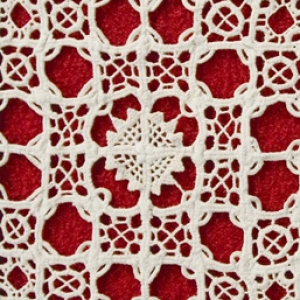Baldyring became very fashionable among urban ladies between 1850 and 1920. It was sometimes regarded as being a ‘true’ Danish national heritage form of embroidery, predating the decline of Danish whitework embroideries and the development of Udklipshedebo.
By the end of the nineteenth century baldyring was being used all over Denmark, especially for tablecloths, tea cosies, and decorative soft furnishings in the living room. Baldyring is regarded as a further development of the Hvidsøm technique, whereby a freehand floral or geometric pattern is embroidered in satin stitch and outline stitch around a larger motif.
The satin stitch motifs in baldyring were often under-tacked (padded with stitching) before the satin stitching was carried out, thus ensuring that motifs stand out. Sometimes a stiletto was used to make small holes (similar to the technique used for broderie anglaise).
In addition to the freehand pattern, open squares are made by drawing out 6-8 warp and weft threads from the ground cloth, followed by 6-8 threads that are left in place, then 6-8 threads drawn out, etc. The edges of the squares are neatened with an overcast stitch. The untouched threads between the squares are strengthened and worked into connecting bars using a needleweaving technique (point de reprise). The open squares are then filled in with embroidered lace using buttenhole stitches.
See also the TRC Needles entries on Hedebo embroidery, An introduction and Hedebo embroidery. The different styles
Sources:
- ANDRESEN, G. (1986). Bondesyninger på lærred 3. Hvidsøm, Baldyring, Udklipshedebo, Falstersyning. Historie og Teknik, Borgen: Narayana Press, Gylling.
- BUUS, H. (2008). Hedebosyning: en verden af variationer: katalog (Vol. 1. udgave), [Greve]: Greve Museum.
- HVIDBERG, E. H. J. (2000). Tulipanen i Hedebosyningen (Tulips in Hedebo Needle Lace), Jelling Bogtrykkeri A/S: Greve Museum.
- GLIENKE, Laila and K. EGHOLK (2008). Kulturarv med nål og tråd: hedebosyning for børn og unge. undervisningsmateriale fra Greve Museum 2008, Greve Museum.
- http://www.grevemuseum.dk (retrieved 13rd May 2016).
Digital source of illustration (retrieved 6th July 2016).
LG

